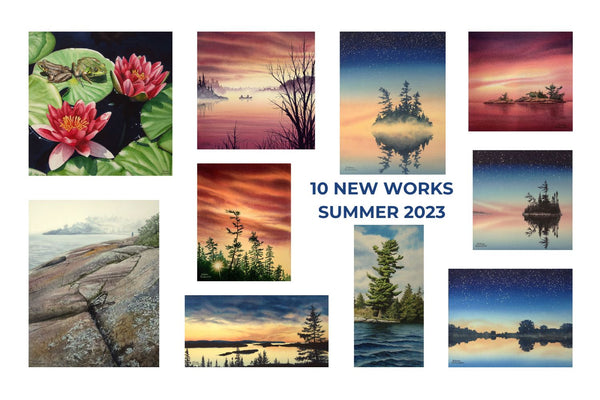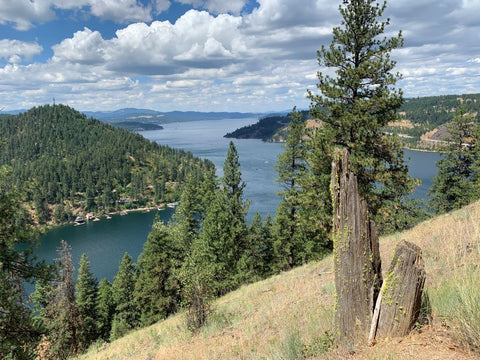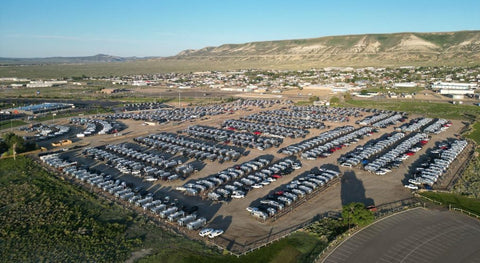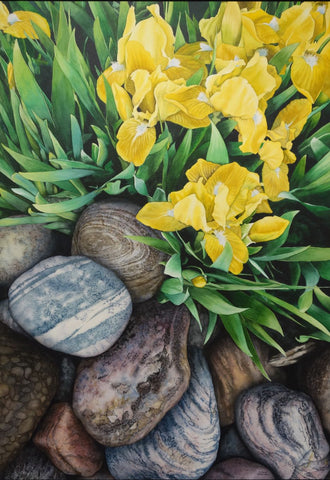
My husband and I thoroughly enjoyed exploring western USA and Canada in our Airstream trailer this year. It has all the comforts of a small apartment, and I often refer to it as our mobile condo.
During the 20 weeks we were away, we drove just over 20,000 km which made for a comfortable, relaxed pace. Some locales we visited only a day or two, and others had us settling in for a week or more, depending on what there was to see and do in the area.

In previous blog posts I shared my favourite photo highlights from the first half of our trip. If you missed them, here are the links:
My Summer Travels in the High Desert
Pacific Northwest: Forests and Freshwater.
I will be sharing more travel stories and including videos and photo highlights of our trip in coming months, as time permits. I have a lot of painting to do, since the fall and winter seasons are when I produce the majority of my artwork.

However, as we travelled, I made sure to take time for a few hours of painting every week or so.
I have learned that this regular creative time is essential to my well-being. I get cranky if I have a long stretch of time without having fun making art.
My husband would go off to see a car show or for a walk, and I would set up my portable studio at the dinette in our trailer, as pictured here.

My painting setup is very simple: a fistful of brushes, two small travel palettes, a dozen small tubes of paint, pre-cut sheets of watercolour paper, a few foam board supports, and some reference photos. I also employ a folding LED desk lamp, old rags to protect the dinette surfaces, and some repurposed pantry equipment.
I generally had three paintings in progress at any one time, so if I had to stop working on a painting while it dried, I could work on another one in the meantime.
Getting all my equipment set up at the dinette takes about five minutes, so it is no trouble to paint for just two or three hours, and then put everything away.
Cleanup takes about ten minutes, including washing my brushes. Watercolour is especially suitable for a mobile studio like this, as there are no solvents needing disposal.

To avoid the risk of mould or mildew, I have to let my paintings, brushes, and rags dry fully before I pack them away. I also need to let my palettes dry so the paint won't spill during storage. Watercolour paint can be reused another day, by adding water to dissolve the dried paint. This is another factor that makes this medium ideal for travel.
I came up with the idea of using the shower stall in our Airstream bathroom as an overnight drying area. This keeps all the materials out of our way so we can use the living area of the trailer. This photo shows three paintings drying after a painting session.
The shower seat holds the paintings on their supports as well as my palettes. On the floor is a zippered clear plastic bag (the kind that blankets come packaged in) that I use as a storage case. Resting on top of that is a rag and my wet brushes. The shower stall has a small retractable clothesline (not shown in the photo) that I use to hang more rags to dry.
After drying, all my painting supplies fit into the blanket bag, which I then stow into one of our overhead cupboards in the Airstream.

I was very happy to complete these ten new paintings during our travels. That equates to an average of one painting every two weeks.

Back home in my art studio, I mounted the watercolour paintings onto archival wood panels, shown here.
I use various heavy objects at hand (including my awesome pebble collection) to help affix the watercolour paper to the cradled panels.
Once the adhesive was dry, these paintings were trimmed, varnished, and framed. A few of these new paintings have found their forever homes and the rest are being delivered to my retail galleries in Huntsville, Fenelon Falls, and Port Perry, ON. To view details and locations of the remaining pieces, visit the New Paintings page on my web site.
For a complete description of how I mount and varnish my watercolours, see my article Framing Watercolours Without Glass.
We had a wonderful holiday and it feels great to be back home again. I am keen to start on several large scale northern landscape paintings in my roomy studio. Now that cold weather is here, my little gas fireplace will be put to good use.
If you have comments you wish to share, please do so using the 'Leave a Comment' button at the top of this post.
Subscribe to Karen's Newsletter for exclusive early access to new work, studio news updates, travel tales, painting tips, and notices of upcoming exhibitions.




































 Over the past winter and spring, I have devoted myself to building a fresh collection of landscape paintings, destined for display and sale at my retail gallery partners.
Over the past winter and spring, I have devoted myself to building a fresh collection of landscape paintings, destined for display and sale at my retail gallery partners. Living the Dream, varnished watercolour on 12 x 12 inch panel
Living the Dream, varnished watercolour on 12 x 12 inch panel Quality Time, varnished watercolour on 9 x 12 inch panel
Quality Time, varnished watercolour on 9 x 12 inch panel Daybreak, varnished watercolour on 10 x 10 inch panel
Daybreak, varnished watercolour on 10 x 10 inch panel Dancing in the Dark, varnished watercolour on 12 x 12 inch panel
Dancing in the Dark, varnished watercolour on 12 x 12 inch panel  Steadfast and True, varnished watercolour on 16 x 12 inch panel
Steadfast and True, varnished watercolour on 16 x 12 inch panel 








 I decided to spend a few months this winter and spring focusing on painting cloudy sunset scenes, to try to determine where I had been going wrong in the past, and figure out what strategies might work better.
I decided to spend a few months this winter and spring focusing on painting cloudy sunset scenes, to try to determine where I had been going wrong in the past, and figure out what strategies might work better.
 The painting was inspired by this photograph I took of the view from my bedroom window last December. The trees grow in the hedgerow between farm fields behind our house, and every morning I look out my window to absorb the beauty of nature.
The painting was inspired by this photograph I took of the view from my bedroom window last December. The trees grow in the hedgerow between farm fields behind our house, and every morning I look out my window to absorb the beauty of nature. The Wonder of It All, varnished watercolour on 6 x 12 inch panel depicts a glowing sunset over a northern lake. Sometimes I look at a splendid sky and just have to marvel at the artistry of nature. She creates the most marvellous paintings, just using light and water vapour. I am awed by the wonder of it all.
The Wonder of It All, varnished watercolour on 6 x 12 inch panel depicts a glowing sunset over a northern lake. Sometimes I look at a splendid sky and just have to marvel at the artistry of nature. She creates the most marvellous paintings, just using light and water vapour. I am awed by the wonder of it all. The painting was inspired by this photo of Six Mile Lake in Muskoka, taken by Sharon Hopkirk and used with her gracious permission.
The painting was inspired by this photo of Six Mile Lake in Muskoka, taken by Sharon Hopkirk and used with her gracious permission. I was still entranced by Sharon's gorgeous photo, and started a second attempt at painting the full scene. I took a photo at the end of each day so I could show you the layering process.
I was still entranced by Sharon's gorgeous photo, and started a second attempt at painting the full scene. I took a photo at the end of each day so I could show you the layering process.











